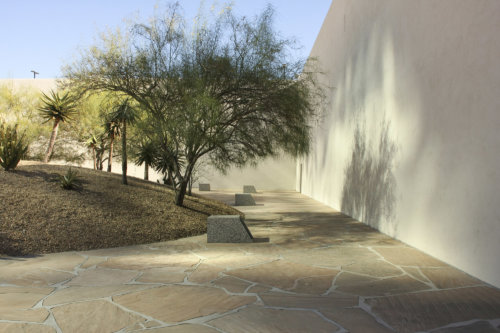
Isamu Noguchi’s Hidden Public Sculpture Garden Explores 7 Landscapes in “California Scenario”
If I were to tell you I knew of a garden that was smack dab in the middle of the nation’s most extensive suburban sprawl, conveniently located just feet off the busiest interstate in America and a block away from its highest grossing mall, would you check it out? Bear with me as I implore you to do so.
Situated on a 1.6-acre former lima bean plot, “California Scenario” is a publicly accessible garden wedged in between two corporate office buildings and a massive parking garage. No matter how you frame it, this is not where you’d expect to meander and bounce between seven scenes of uniquely Californian landscape as interpreted by Isamu Noguchi (1904-1988), one of the most celebrated sculptors of the 20th century. To call it a hidden gem is grossly self-evident.
The hard edges of towering mirrored glass and the empty walls of a hidden parking garage might sound off-putting for the containment of a serene garden, but the reflections from the office buildings provides an energizing light and beautiful enhancement at mid-morning.
Arriving just before the lunch hour, I found dozens of people clearly enjoying the plaza-esque space. Billed as “both a metaphorical garden and minimalist theater installation,” this is a sanctuary I would have loved in my years as an office drone– for meditation, for gathering with friends, relaxing, eating, reading, or just getting away from it all. The building management even puts out a bean bag toss, which was getting play, and they also organize a small farmers market, which stayed busy catering to the pre-lunch crowd.
“This is not where you’d expect to meander and bounce between seven scenes of uniquely Californian landscape as interpreted by Isamu Noguchi, one of the most celebrated sculptors of the 20th century. To call it a hidden gem is grossly self-evident.”
Unlike so many gardens where green is the theme, Noguchi, a native Californian, wanted to “get back at all the green grass you see all over the place.” Using indigenous plants and materials, such as cactuses, eucalyptus, palo verde trees, redwoods, and granite boulders, visitors are presented with seven distinct depictions of nature.
A river flows from a 30-foot “Water Source” triangular mountain and ends at a smooth granite wedge, “Water Use,” which symbolizes civilization. Much like the water situation in California, the river ranges from being full to dry throughout its path. Nine towering redwood trees, accentuated by a grassy slope, invite those needing a private moment to sit atop on a bench at “Forest Walk.”
The “Energy Fountain” pulsates with a constant flow of water, while the sculptural granite pile, “Spirit of the Lima Bean,” embodies the land’s former use. “Land Use” and “Desert Land” are both plant filled knolls covered with greenery and desert plants, respectively.
Instead of being encroached upon by the surrounding architecture, California Scenario, much like its desert muse, inspires the distinct feeling of expanse. It is the spaces in between that give the seven areas their meaning.
The masterful placement of the large granite stones, sculptures and knolls amidst much larger areas of red rock flooring underlines the idea that the land is bigger than its own creations– in this case capitalism, car culture, and consumerism. Perhaps not ironically, California Scenario is surrounded by the state’s own excesses and successes. Interstate 405, the busiest freeway in the country, is miraculously hidden, but just steps to the west and one of the largest, most elite, and highest grossing malls in America, South Coast Plaza, is one block away.
The vicinity is not a coincidence. The agricultural tycoon, Henry Segerstrom, owner of South Coast Plaza and avid arts patron, commissioned this space in 1979 to his longtime friend, Noguchi, who finished the work in 1982. Just a decade prior, Segerstrom created the mall on his family’s lima bean farmland.
Noguchi had initially declined the offer to provide a sculpture for a garden on the site (citing the uninspiring surroundings), suggesting instead to design the work in its entirety. We are glad he did. This garden delight, this microcosm of California, should be enjoyed by all residents and visitors alike– it’s a Southland creation worth valet parking for.
Strange as the setting might first seem, this abstract interpretation of an artist’s homeland could not be more perfectly situated, nor more perfectly needed right where it is. Noguchi expressed hope that his creation would be a place that people could escape from the world that surrounds them. And it is. As he states: “That’s the purpose of a garden, is it not?”
California Scenario is located at 611 Anton Avenue in Costa Mesa, California. The garden is a public space open from 8 AM to midnight and is lit in the evenings.




































